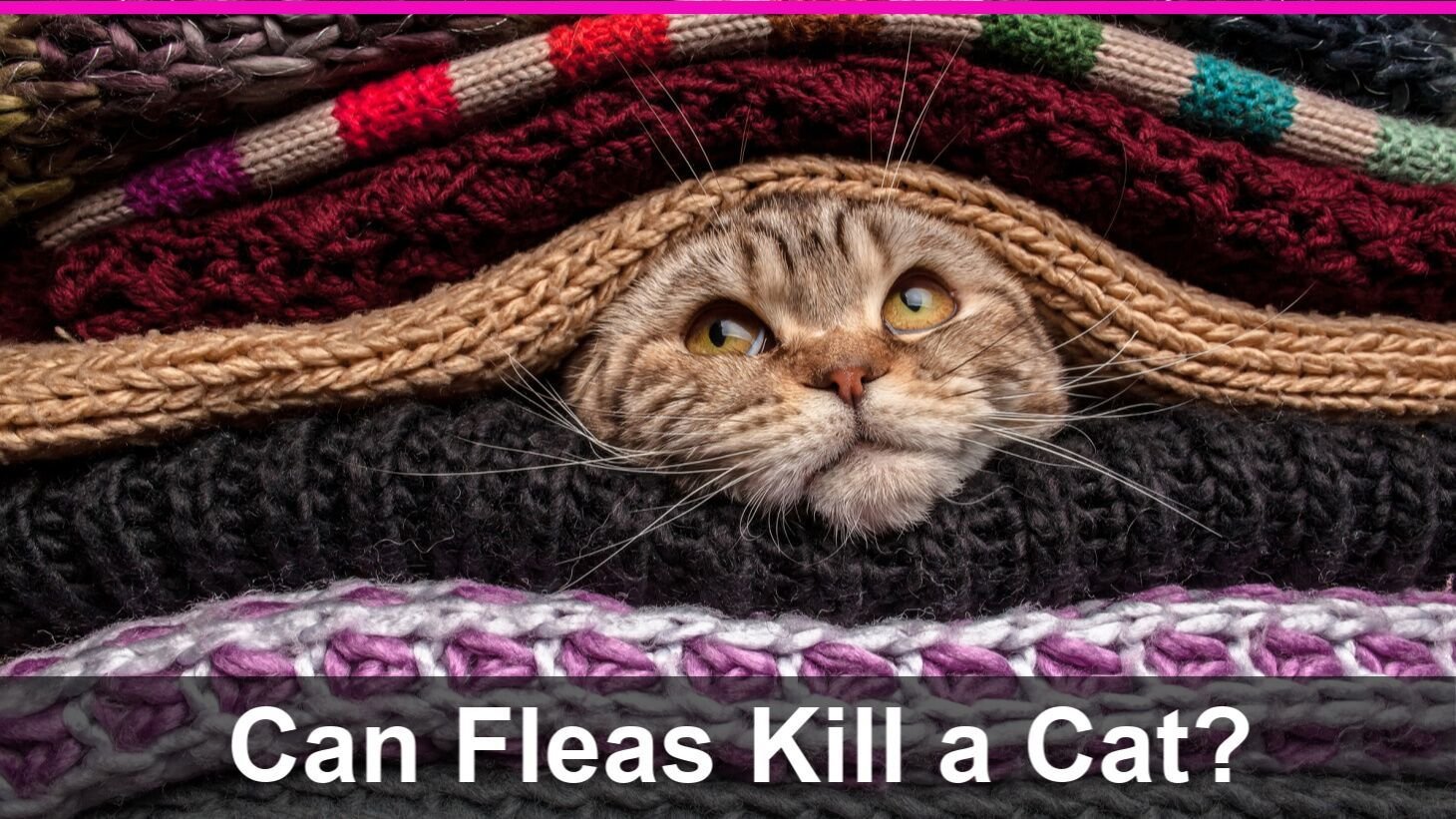Fleas are a nuisance, and an inevitability of cat parenting. But left untreated, fleas can be more than a minor irritation. A severe flea infestation can kill a cat or kitten.
But don’t worry, if you just see a few little beasts on your cat’s back, you’re going to be okay. Just treat them with either an over-the-counter or natural flea treatment.
A severe flea infestation can kill a cat or kitten. Fleas can cause diseases and conditions such as anemia, Feline Homotrophic Mycoplasmosis (FHM), and plague, which, when left untreated, can cause death. However, death from fleas is very rare.
Flea-Born Diseases That Can Kill or Cause Illness in Cats
Fleas become a bigger problem than itchy skin when the infestation leads to anemia, or one of these deadly flea-transmitted diseases.
Anemia
Fleas live off the blood supply from their host. When your cat is carrying too many fleas, it loses a lot of blood and suffers from anemia – a deficiency of white blood cells or hemoglobin in the blood. Anemia from flea bites can be deadly.
Symptoms of flea bite anemia in cats: weakness, lethargy, and pale gums.
If your cat is suffering from these symptoms, in addition to the itching and scratching, a flea treatment alone is not enough. Get them to the vet. They may need iron supplements and possibly a blood transfusion. Even then, if you have a small kitten or a very old cat, they may not make it through.
Feline Hemotrophic Mycoplasmosis (FHM)
Formerly called haemobartonellosis, FHM is a parasite that can be transmitted by fleas. This parasite destroys your cat’s red blood cells and causes severe anemia.
Symptoms of FHM: pale, white, or yellow linings of the eyes and/or gums; fatigue, lethargy, drastic weight loss, increased heart rate, rapid breathing, enlarged spleen, enlarged lymph nodes, anemia.
If your cat is experiencing one or more of these symptoms, make an appointment with your veterinarian. They will run a PCR assay and likely a FeLV/FIV test. If found positive for FHM, your cat will be treated with a course of antibiotics in addition to a flea treatment.
If you have more than one cat and there is a flea infestation, make sure you treat all your cats for fleas and get them checked by a veterinarian. FHM parasite is not spread directly from cat to cat, but it is spread by the transfer of infected fleas.
The Plague
Yes, the plague. Contrary to popular belief, this flea-transmitted deadly disease did not disappear after the Dark Ages.
The plague is most commonly active in the southwest (in the United States) between the late spring and early fall, so be especially careful of your outdoor cats during that time.
Plague is carried by infected fleas through rodents, and your cat can get it either from one of those flea bites or by ingesting an infected mouse, mole, rat, or squirrel.
There are three types of plague that present with varied symptoms.
Symptoms of Bubonic Plague and Septicemic in cats: rapid weight loss, fever, vomiting, dry mouth and dehydration, swollen head and neck, mouth ulcers, eye discharge, diarrhea, swollen tonsils, swollen lymph nodes that could abscess. If the cat survives, untreated it could end up in a coma. With Septicemic Plague, a blood infection will also present.
Pneumonic Plague symptoms in cats: lung infection.
If your cat has one or more of these symptoms, take them to a vet immediately. Early intervention and treatment are necessary for a cat infected with plague to survive. Your cat will be isolated in a veterinary hospital and treated with antibiotics and potentially rehydration, as well as a flea treatment.
To ensure the safety of your other cats, pets, and yes, even humans, in your home, get every pet and person tested. You may want to do a commercial flea treatment at this point, and keep your environment clear of garbage, clutter like dead branches and wood, and anything else that might attract infected-flea-carrying rodents.
It is important to notify public health officials immediately when a cat is suspected of having or diagnosed with the plague. They will assist you in securing the area for prevention of further infection.

Our review process is unbiased and based on extensive research. If you buy through the links on our site, we may earn a commission.
Tapeworms (Not Deadly, but “Ick”)
If your cat swallows a flea carrying tapeworms inside of it, your cat will end up with tapeworms in its intestines. Tapeworms are not deadly. However, they will cause your cat to vomit and have diarrhea. This could start to cause malnourishment and fatigue.
You can identify tapeworms by looking around your cat’s anus. It will look like bits of white rice stuck to their backsides. These are tapeworm larvae, which will hatch and continue the cycle of reinfestation.
You will want to first, treat the fleas either with an over-the-counter, professional, or natural flea remedy. And second, deworm your cat either professionally by your vet or with an at-home product like Bayer Tapeworm Cat Dewormer.

>> Tap Here To Read Reviews And See Today’s Best Price On Chewy.com <<
Flea Allergy Dermatitis
Again, this is an uncomfortable symptom of fleas in cats, but it’s not deadly. Flea allergy dermatitis is a condition where your cat becomes allergic to the flea’s saliva.
When the flea bites your cat, just one bite can cause serious itching and pain. This can lead to hair loss and scabs from the cat scratching at biting at the irritated skin.
Symptoms of Flea Allergy Dermatitis: scratching and chewing at one spot on the cat’s body (usually at the base of the tail), scabbing and localized baldness.
Your best bet is to treat your cat with an over the counter or natural flea treatment.
The Most At-Risk Cats to Flea-Transmitted Disease

Kittens, elderly cats, and cats with compromised immune systems are most susceptible to diseases from flea bites becoming life-threatening. It’s important that you take proper precautions to protect these vulnerable cats from fleas.
Consider keeping these cats and kittens indoors and isolated from other pets, wash their bedding regularly, and keep up with their flea prevention protocol.
Cats who are allowed to roam outdoors are at a higher risk for contracting fleas and flea-transmitted diseases than indoor cats. This is because the fleas are carried on wildlife, such as rodents, as well as other cats and dogs.
Preventing and Treating a Common Flea Infestation
Rescued abandoned and lost casts are the most commonly in need of treatment for flea-related deadly disease or major flea infestation. These cats have greater exposure and go longer without treatment. But, a bad case of the fleas can occasionally descend upon your indoor or outdoor family pet.
If you’re paying close, daily attention to your cat, it’s unlikely that flea bites will become deadly. If you’re concerned about fleas, the first step is to take some flea prevention measures, like an oral or topical flea prevention plan or flea collar.
Next, make sure your cat’s environment is free from food and trash, the floors and carpeting are clean, and upholstery is vacuumed regularly. Wash your cat’s bedding in soap and hot water once a week.
How to Check for Fleas on Your Cat
Check for fleas on your cat periodically. You’re looking for a small, brownish, flat insect that’s super-quick and an expert jumper, so look fast or you might miss it.
Fleas like to hang out in warm, protected areas like the groin and armpits. Turn your cat on its back and part its hair with your thumb and forefinger to check the skin.
Next, check your cat’s ears and the base of its tail for red, bumpy skin or bits of dried blood called where the fleas have bitten and your cat has scratched.
If you suspect fleas but you can’t quite see them, try using a flea comb. Place your cat on top of white paper towels and have a bowl of soapy warm water ready to douse any fleas that you extract. Comb through your cat’s fur carefully.
If you catch fleas in the comb, douse it immediately in the soapy water to kill it. If you’re not seeing fleas, but you suspect an infestation, check the white paper towels. You may see “flea dirt” falling onto the towels.
If you’re not sure about the dirt, sprinkle it in a little warm water. Flea dirt is the flea’s excrement. If the dirt turns the paper towel red, it’s the dried blood rehydrating– that means it’s flea dirt!
Finally – check yourself for bites! If you’re noticing itchy patches of red dots, especially on your feet and ankles, you may have a flea infestation in your carpet, rug, or yard. While fleas do not attach themselves to human hosts, they can live in your carpet for up to 100 days and can be very difficult to get rid of.
At this point, you may want to consider a professional flea removal service. Or, you can clean your carpet and treat it with a carpet powder or spray.
If you find fleas, flea dirt, or flea bites on your cat, you will want to treat them to remove the fleas and eggs immediately. You can use an over-the-counter flea treatment or try one of the natural flea remedies for cats outlined in the article, Natural Flea Remedies for Cats.

